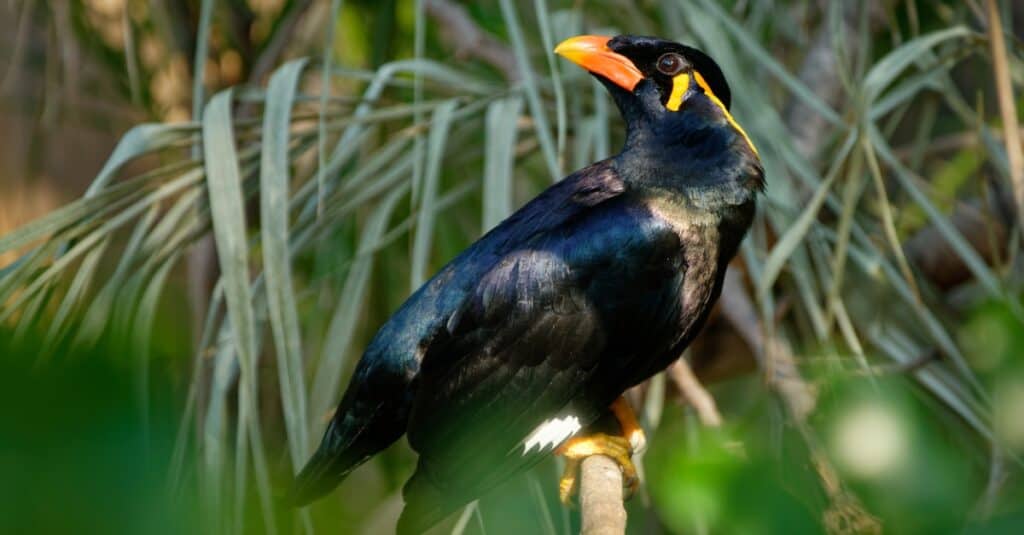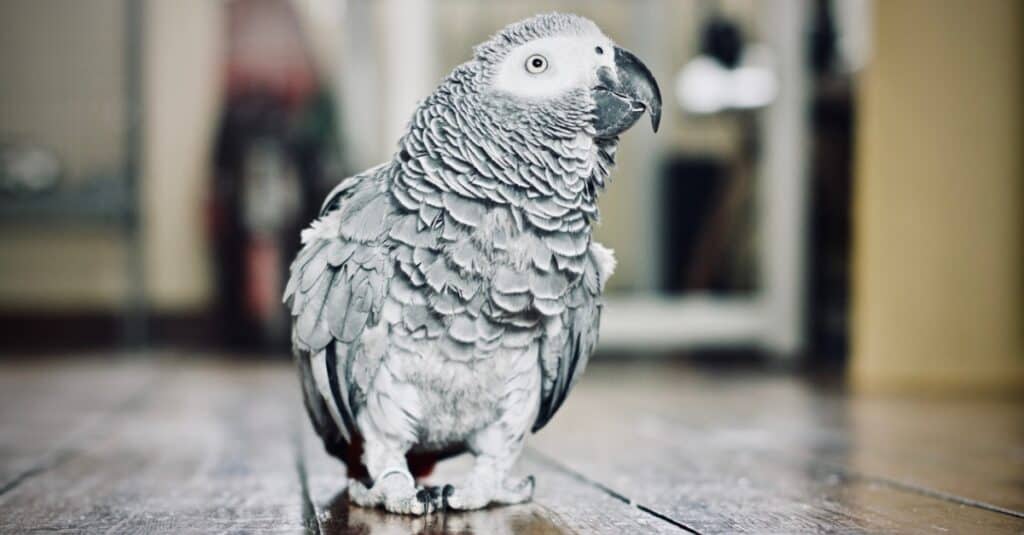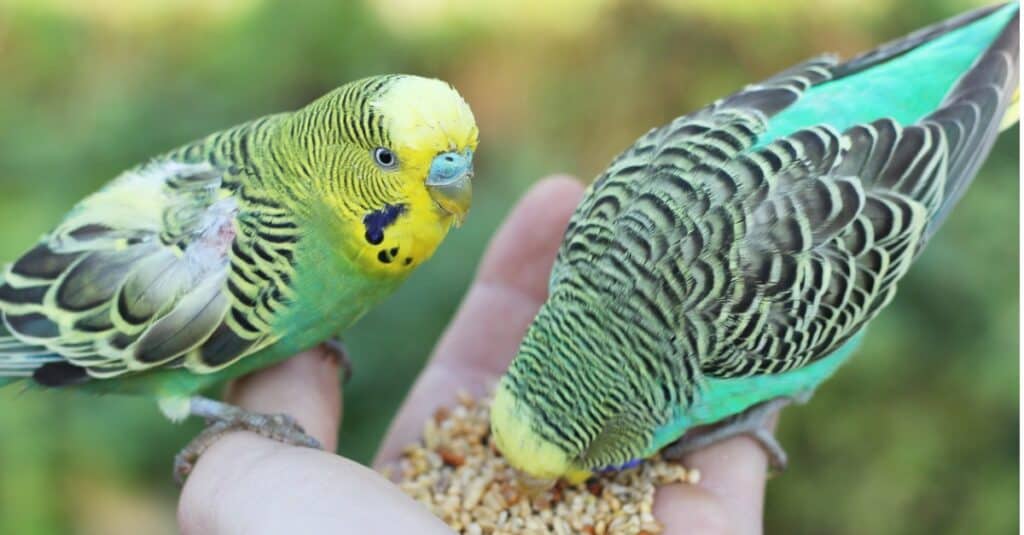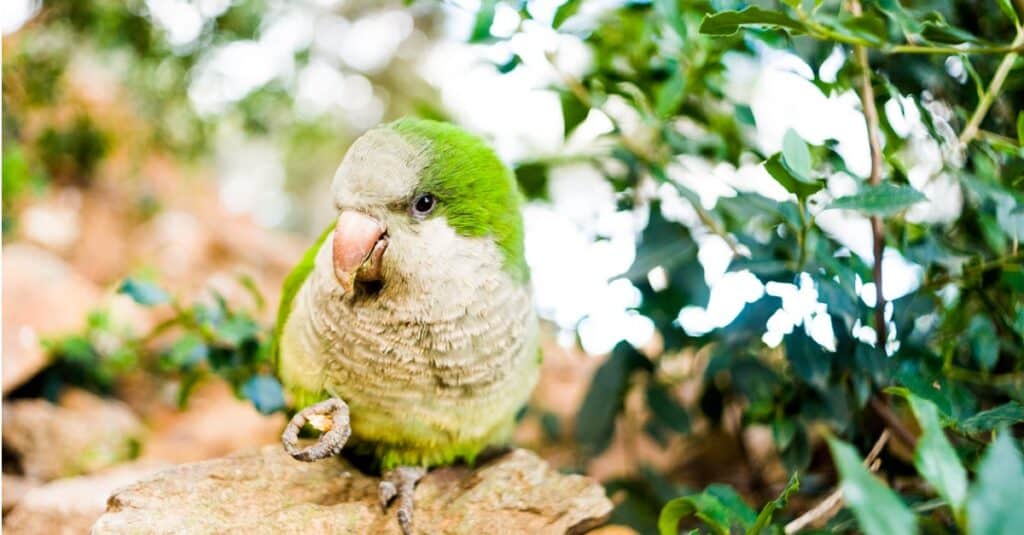While popular media sometimes treats birds as the dunces of the animal kingdom, the truth is quite the opposite. Despite their small brains, many birds develop highly sophisticated social structures with surprisingly diverse and personalized systems of communication. Vocalization serves an important part in both communicating and learning a new behavior, and we’re still beginning to learn the depth of what birds can accomplish. Songbirds and parrots constitute the majority of birds that can mimic human speech, but we’re increasingly discovering that they’re not necessarily the only ones. Here are the different types of talking birds that have been discovered throughout the world.
1. Mynahs: Mimics of More Than Human Speech

©iStock.com/phototrip
Among the countless parakeets, parrots, and other various other different types of talking birds, none arguably speak with more clarity than the mynah bird. They can learn a robust vocabulary consisting of up to 100 words or more, but they outperform different types of talking birds like parakeets and budgies in their ability to replicate the pitch and tone of human language. It’s not just speech that interests these small birds either. They’ve been observed repeating the songs of other birds in their territory and even accurately replicating human tools like car horns and chainsaws.
Mynah birds are prevalent throughout Southeast Asia, but as one of the more popular types of pet birds that talk, they’ve expanded as far afield as North America and Australia. Unfortunately, it’s often an invasive and potentially destructive species in many of these non-native ecosystems. Mynahs are small birds that adapt well to life in cages and have highly sociable personalities that make them some of the better types of pet birds that talk for beginners. That said, not every mynah bird is going to have an interest in speech. Training from an early age and maintaining consistency while also employing positive reinforcement methods will help improve the odds of raising a talkative mynah bird.
2. Grey Parrots: The Most Prodigious Avian Talkers

©iStock.com/Adrian Black
Among the types of pet birds that talk, none are more well-recognized than the parrot. Most parrot species are capable of speech, but none can learn a vocabulary to rival Africa’s grey parrot. A well-trained adult of the species can learn approximately a thousand words. That’s roughly equivalent to a three-year-old human child, and grey parrots have demonstrated cognitive and puzzle-solving skills comparable to children a few years older. And unlike the majority of other types of birds that talk, there’s some indication that the grey parrot can contextualize those words. A study conducted throughout a 26-month training period resulted in a parrot capable of combining nouns, adjectives, and the word “no” to convey their interest — or lack of interest — in a variety of common objects.
Those qualities can make grey parrots a tempting choice for a pet when evaluating the different types of talking birds — but these birds are neither cheap nor easy for beginners to care for. While they bond closely with their human owners, that brings with it a need for nearly constant attention. Both regular socialization and activity are necessary, and these birds can’t learn to speak without the proper training. A member of the species will often cost thousands of dollars, and that’s not factoring in the costs of food, toys, veterinarian bills, and other assorted expenses.
3. Budgerigars: A World Record Holder at Conversation

©iStock.com/urafoc
Commonly known throughout the world as either budgies or parakeets, the budgerigar is one of the most common types of birds that talk. As with other conversational birds, the budgie doesn’t have vocal cords and instead replicates the pitch and sound by expertly squeezing muscles in its throat. Budgies are highly sociable, and the prevailing theory is that pet budgies learn the human language as a part of finding their place within the family structure. These birds can distinguish one another based on their distinct voices, and they can recognize the individual faces and voices of humans as well. Research indicates that males in the wild are more likely to learn new intonations and that this mimicry developed as a form of sexual selection.
Budgies are cheap and common pets that are small enough to fit in a modest-sized cage and easy to care for. But they’re also regularly ranked among the top five talking birds. A parakeet named Puck even earned a spot in the Guinness Book of World Records for possessing a vocabulary of 1,728 words. Smart even by the standards of parakeets, Puck was able to combine words into unique phrases and sentences. For those who want a talking bird but don’t have a lot of money to spare, a budgerigar can be bought for around $25.
4. Quaker Parakeets: Great Conversationalists for Beginners

©iStock.com/beingbonny
Many birds are capable of learning human speech, but few are prone to seriously learning words and phrases without a lot of training and positive reinforcement. That’s not the case with the quaker parrot, also commonly known as the monk parakeet. Quaker parrots are fast and prodigious learners who also mimic songs and other noises in their environment. Chances are that they’ll pick up phrases without any interference from you, though you might not have much control over what words they decide to latch onto.
Quaker parrots are friendly and are generally regarded as a great choice for a pet. Unfortunately, you can’t legally own these parrots everywhere. Several states in the United States have banned quaker parrots as pets because they’re considered an invasive species. They can breed rapidly and pose a serious threat to agriculture in their adopted habitats. They’re also the only species of parrot that nests and quaker parrots in urban environments often favor dangerous and easily destructible power lines and transformers for building their homes.
5. Macaw: The Colorful Conversationalist

©Jeff Schultes/Shutterstock.com
Macaws are very colorful bird breed native to Central and South-America, Mexico, formerly in the Caribbean, and mostly prefer live in forests, however, few of the macaw species have been seen to prefer savannahs over forests. They have a remarkable ability to mimic human speech. The species has been recorded not only repeating words, but also phrases and songs. Unlike other birds which may repeat a word or two, some Macaws are often able to reuse words in context as well, making them uncanny conversationalists.
Macaws supposedly mate for life and enjoy mutual grooming, share food with their partners. Depending on the species Macaws breed once in 1 – 2 years and the female incubates the egg, while the male looks for food. Unlike the cockatoos macaws are not very friendly with people that they don’t know very well. They also have a very unique diet as they eat:
- Seeds found in native areas
- Fruits
- Nectar
- Palm nuts
- Flowers
- Tree leaves
- Figs
- Surprisingly some macaws eat the clay found in exposed river banks.
In addition to being a great exotic pet choice, they are one of the most popular talking pet bird breeds.
Summary
Here is the list of talking birds across the globe:
| No | Bird Species Name |
|---|---|
| 1 | Mynahs |
| 2 | Grey Parrots |
| 3 | Budgerigars |
| 4 | Quaker Parakeets |
| 5 | Macaw |
Up Next…
- Bird Of Paradise: Interested in exotic birds? Find out what makes the ‘Bird of Paradise’ special.
- The Best Macaw Cages in 2022? We Reviewed: Looking for the best cage for your Macaw? Find out what our experts have chose for you.
- Birds: Different Types, Definition, Photos, and More: Are you a bird novice? Here is a guide and facts that will help you learn about bird species around the world.
The photo featured at the top of this post is © starry sky/Shutterstock.com
Thank you for reading! Have some feedback for us? Contact the AZ Animals editorial team.






